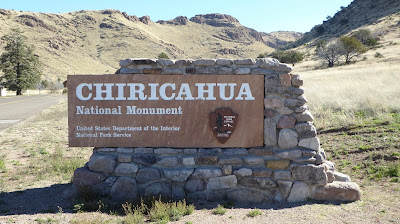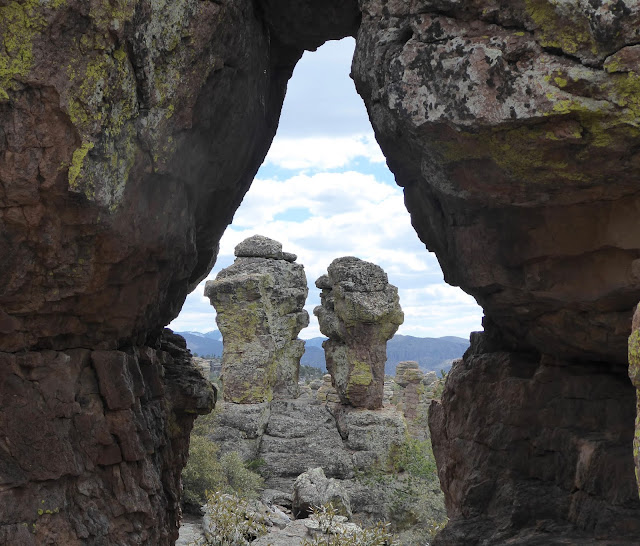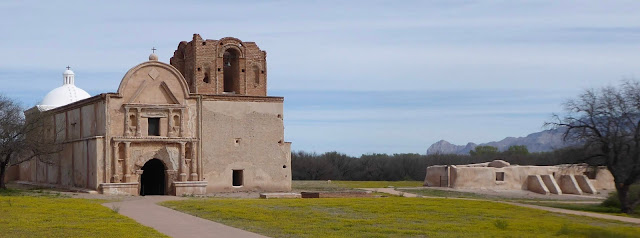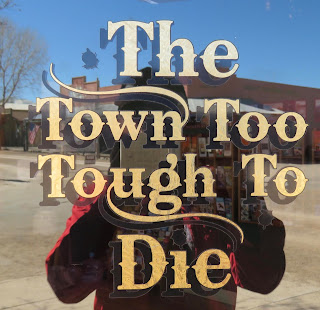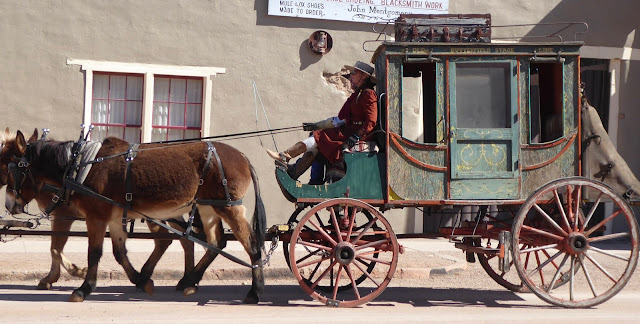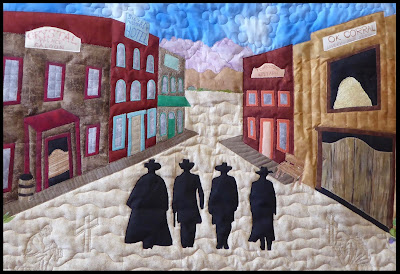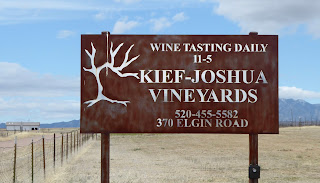Carol writes: As we travel from campground to campground along our nation’s interstate highway system, we have noticed thousands of campgrounds that butt right up against the interstate. Many times we have commented to each other, “Who stays in such noisy campgrounds?”
Well, that would be us! We have joined the ‘noisy campground’ ranks, because in Willcox, Arizona, there really was no other good choice. The Willcox-Cochise KOA was a neatly maintained, newly updated campground that was just about perfect in every way…
except for the grinding traffic noise of Interstate 10. And, as “luck” would have it, our site was among the closest to I-10, bustling with all the semis rolling by…
As it turned out, the wind was howling so much when we arrived that we delayed extending our slides or raising our Direct TV satellite dish until early evening. What traffic noise? For the next few hours, the wind was so loud and we were so well insulated inside our cozy bus that any traffic noise was insignificant!
We soon discovered that although the old-town part of Willcox appeared “just a few heartbeats short of a ghost town,” for a sandhill crane this was a pretty ideal place to spend the winter months. The next day we headed over to a large marshy lake area surrounded by magnificent grasslands and the soaring mountain scenery of Dos Cabezas.
It wasn’t long before we spotted— and heard—a large flock of sandhill cranes circling and swooping overhead after coming back from a morning of feeding in the mountains.
For the next hour, we were mesmerized by the landing behavior of this very large flock of noisy sandhill cranes. In a most organized manner, small groups of birds peeled off from the main flock and slowly spiraled down to their chosen nesting spot for the night.
As each small flock of cranes got close to the landing zone, each member dropped long skinny legs, much like a human parachutist, and within seconds had landed.
Meanwhile, all bird behavior on the ground was amazingly calm and quiet.
There was a method to our madness for choosing a campground so close to the I-10 corridor, and that was for the opportunity to visit two national sites on our bucket list.
FORT BOWIE NATIONAL HISTORIC SITE
The story at Fort Bowie was closely tied to the Army’s efforts to subdue the hostile Chiricahua Apaches, led first by Cochise and then by Geronimo. The other crucial mission of the soldiers at Fort Bowie was to protect the vital water supply at Apache Spring, which was positioned along the transport corridor known as Apache Pass, a key route for westward expansion in the mid-19th century.
The only way for today’s visitors to visit Fort Bowie was to hike a 1-1/2-mile trail through an historic valley in Apache Pass.
Along the way we passed the skeletal stone foundation of the Butterfield Stage Station, a stopping point on the old overland mail route.
A little further up the trail we came to the Fort Bowie cemetery.
Since most of the graves of Fort Bowie soldiers and their dependents have been relocated to a national cemetery, 23 civilian gravesites were all that remained at the post cemetery. The gravesite of Geronimo’s 2-year-old son, Littlerobe, and very young Medal of Honor recipient O.O. Spence were most noteworthy.
We encountered a bit of a climb through a hilly canyon up to the grounds of the fort, but once we crested the hill, the strategic advantage of this relatively level site was apparent.
A few adobe-reinforced stone walls were all that remained of what was once a fully functional frontier Army fort.
It was interesting to compare our photograph of Fort Bowie to one that was taken on a quiet January day in 1894.
After final surrender in 1886, Geronimo and his followers were brought to Fort Bowie, then put on a train for the long and sad journey to exile in Florida. I was most fascinated by an old photograph that depicted Geronimo in a casual moment on the parade grounds of Fort Bowie. Geronimo was pictured to the right with hands on hips.
Shortly after Geronimo was captured, Fort Bowie closed. Local ranchers salvaged lumber from vacant buildings for personal use, leaving history’s story to be told by the ghostly stone outlines of what was once a strategic frontier Army post.
CHIRICAHUA NATIONAL MONUMENT
Prior to Geronimo’s surrender in 1886, the grand rock pinnacles that tower over the valleys of Chiricahua National Monument were once home to the Chiricahua Apaches, who called these rock formations The Land of Standing-up Rocks.
This wonderland of rocks has a volcanic origin dating back 27 million years. Over many eons, uplift and erosion between the columns has created massive layered pinnacles of volcanic gray rock called rhyolite.
After Geronimo’s surrender, the story at Chiricahua continued at Faraway Ranch,
the peach and green adobe home of Swedish immigrants Neil and Emma Erickson. Neil and Emma raised three children at the ranch.
The ranger-guided tour of the ranch house was a wonderful peek back to a time when the Erickson children used their much-loved homestead as a guest ranch.
The children and their spouses were very civic-minded and devoted much of their lives to fostering appreciation of the land they treasured. Their dependents built trails throughout the park and lobbied our government for its protection.
It was to those very trails that we turned in order to explore one of our nation's very special treasures.
Monument literature stated that the 3.3-mile Echo Canyon Loop Trail is considered the premier trail of the monument. As we headed into Echo Canyon, the trail wound through wondrous rock formations that were a photographer’s delight.
Giant boulders that seemed impossibly balanced were the ones that beckoned our camera shots.
The trail section through so-called “Wall Street” had natural vertical walls that almost looked man made.
A convenient stone bench served as a perfect lunch spot.
When we looked into the distance along Echo Canyon Trail, we got to thinking that one day of hiking didn’t seem sufficient at Chiricahua. After we heard about an early-morning shuttle van that would transport us to the high point in the monument, thus enabling us to hike 7.3 miles “mostly” downhill along other scenic trails, we were convinced we needed another day.
After a van ride to the top, we had lots of energy for an early-morning start.
Almost no wind and warm sun created ideal hiking conditions.
Our plan was to get to the Heart of the Rocks Loop for a look at some of the most unusual rock formations in the monument. This trail was difficult with lots of huge rock steps, but it was worth it to see the famous rock formation known as “Punch and Judy,” who have been shouting at each other for thousands of years.
The last section of the trail back to the Visitors Center was downhill through Rhyolite Canyon where, fittingly, we were surrounded by some of Chiricahua’s best wilderness scenery.
Well, that was a satisfying week camped along Interstate 10 in southeastern Arizona. Time to head over the state border to Silver City, New Mexico, where our next campsite backed up to the city cemetery and promised lots of peace and quiet.
Carol Galus
Photo-Blogger



















